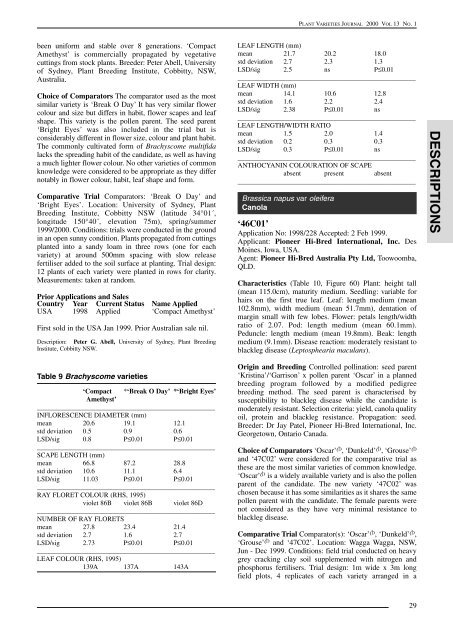53. Volume 13- Number 1 - IP Australia
53. Volume 13- Number 1 - IP Australia
53. Volume 13- Number 1 - IP Australia
Create successful ePaper yourself
Turn your PDF publications into a flip-book with our unique Google optimized e-Paper software.
DESCR<strong>IP</strong>TIONS<br />
PLANT VARIETIES JOURNAL 2000 VOL <strong>13</strong> NO. 1<br />
been uniform and stable over 8 generations. ‘Compact<br />
Amethyst’ is commercially propagated by vegetative<br />
cuttings from stock plants. Breeder: Peter Abell, University<br />
of Sydney, Plant Breeding Institute, Cobbitty, NSW,<br />
<strong>Australia</strong>.<br />
Choice of Comparators The comparator used as the most<br />
similar variety is ‘Break O Day’ It has very similar flower<br />
colour and size but differs in habit, flower scapes and leaf<br />
shape. This variety is the pollen parent. The seed parent<br />
‘Bright Eyes’ was also included in the trial but is<br />
considerably different in flower size, colour and plant habit.<br />
The commonly cultivated form of Brachyscome multifida<br />
lacks the spreading habit of the candidate, as well as having<br />
a much lighter flower colour. No other varieties of common<br />
knowledge were considered to be appropriate as they differ<br />
notably in flower colour, habit, leaf shape and form.<br />
LEAF LENGTH (mm)<br />
mean 21.7 20.2 18.0<br />
std deviation 2.7 2.3 1.3<br />
LSD/sig 2.5 ns P≤0.01<br />
____________________________________________________<br />
LEAF WIDTH (mm)<br />
mean 14.1 10.6 12.8<br />
std deviation 1.6 2.2 2.4<br />
LSD/sig 2.38 P≤0.01 ns<br />
____________________________________________________<br />
LEAF LENGTH/WIDTH RATIO<br />
mean 1.5 2.0 1.4<br />
std deviation 0.2 0.3 0.3<br />
LSD/sig 0.3 P≤0.01 ns<br />
____________________________________________________<br />
ANTHOCYANIN COLOURATION OF SCAPE<br />
absent present absent<br />
____________________________________________________<br />
Comparative Trial Comparators: ‘Break O Day’ and<br />
‘Bright Eyes’. Location: University of Sydney, Plant<br />
Breeding Institute, Cobbitty NSW (latitude 34°01´,<br />
longitude 150°40´, elevation 75m), spring/summer<br />
1999/2000. Conditions: trials were conducted in the ground<br />
in an open sunny condition. Plants propagated from cuttings<br />
planted into a sandy loam in three rows (one for each<br />
variety) at around 500mm spacing with slow release<br />
fertiliser added to the soil surface at planting. Trial design:<br />
12 plants of each variety were planted in rows for clarity.<br />
Measurements: taken at random.<br />
Prior Applications and Sales<br />
Country Year Current Status Name Applied<br />
USA 1998 Applied ‘Compact Amethyst’<br />
First sold in the USA Jan 1999. Prior <strong>Australia</strong>n sale nil.<br />
Description: Peter G. Abell, University of Sydney, Plant Breeding<br />
Institute, Cobbitty NSW.<br />
Table 9 Brachyscome varieties<br />
‘Compact *‘Break O Day’ *‘Bright Eyes’<br />
Amethyst’<br />
____________________________________________________<br />
INFLORESCENCE DIAMETER (mm)<br />
mean 20.6 19.1 12.1<br />
std deviation 0.5 0.9 0.6<br />
LSD/sig 0.8 P≤0.01 P≤0.01<br />
____________________________________________________<br />
SCAPE LENGTH (mm)<br />
mean 66.8 87.2 28.8<br />
std deviation 10.6 11.1 6.4<br />
LSD/sig 11.03 P≤0.01 P≤0.01<br />
____________________________________________________<br />
RAY FLORET COLOUR (RHS, 1995)<br />
violet 86B violet 86B violet 86D<br />
____________________________________________________<br />
NUMBER OF RAY FLORETS<br />
mean 27.8 23.4 21.4<br />
std deviation 2.7 1.6 2.7<br />
LSD/sig 2.73 P≤0.01 P≤0.01<br />
____________________________________________________<br />
LEAF COLOUR (RHS, 1995)<br />
<strong>13</strong>9A <strong>13</strong>7A 143A<br />
Brassica napus var oleifera<br />
Canola<br />
‘46C01’<br />
Application No: 1998/228 Accepted: 2 Feb 1999.<br />
Applicant: Pioneer Hi-Bred International, Inc. Des<br />
Moines, Iowa, USA.<br />
Agent: Pioneer Hi-Bred <strong>Australia</strong> Pty Ltd, Toowoomba,<br />
QLD.<br />
Characteristics (Table 10, Figure 60) Plant: height tall<br />
(mean 115.0cm), maturity medium. Seedling: variable for<br />
hairs on the first true leaf. Leaf: length medium (mean<br />
102.8mm), width medium (mean 51.7mm), dentation of<br />
margin small with few lobes. Flower: petals length/width<br />
ratio of 2.07. Pod: length medium (mean 60.1mm).<br />
Peduncle: length medium (mean 19.8mm). Beak: length<br />
medium (9.1mm). Disease reaction: moderately resistant to<br />
blackleg disease (Leptosphearia maculans).<br />
Origin and Breeding Controlled pollination: seed parent<br />
‘Kristina’/‘Garrison’ x pollen parent ‘Oscar’ in a planned<br />
breeding program followed by a modified pedigree<br />
breeding method. The seed parent is characterised by<br />
susceptibility to blackleg disease while the candidate is<br />
moderately resistant. Selection criteria: yield, canola quality<br />
oil, protein and blackleg resistance. Propagation: seed.<br />
Breeder: Dr Jay Patel, Pioneer Hi-Bred International, Inc.<br />
Georgetown, Ontario Canada.<br />
Choice of Comparators ‘Oscar’ A , ‘Dunkeld’ A , ‘Grouse’ A<br />
and ‘47C02’ were considered for the comparative trial as<br />
these are the most similar varieties of common knowledge.<br />
‘Oscar’ A is a widely available variety and is also the pollen<br />
parent of the candidate. The new variety ‘47C02’ was<br />
chosen because it has some similarities as it shares the same<br />
pollen parent with the candidate. The female parents were<br />
not considered as they have very minimal resistance to<br />
blackleg disease.<br />
Comparative Trial Comparator(s): ‘Oscar’ A , ‘Dunkeld’ A ,<br />
‘Grouse’ A and ‘47C02’. Location: Wagga Wagga, NSW,<br />
Jun - Dec 1999. Conditions: field trial conducted on heavy<br />
grey cracking clay soil supplemented with nitrogen and<br />
phosphorus fertilisers. Trial design: 1m wide x 3m long<br />
field plots, 4 replicates of each variety arranged in a<br />
29

















